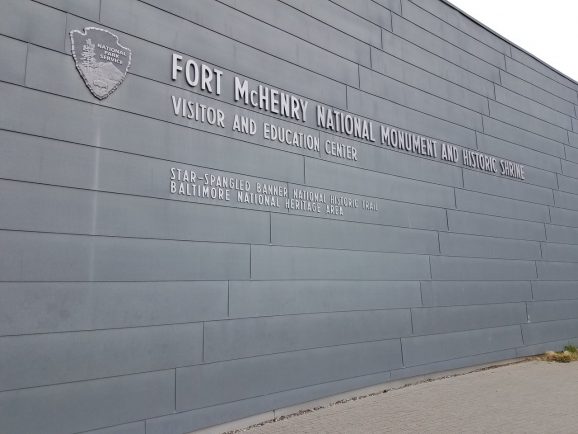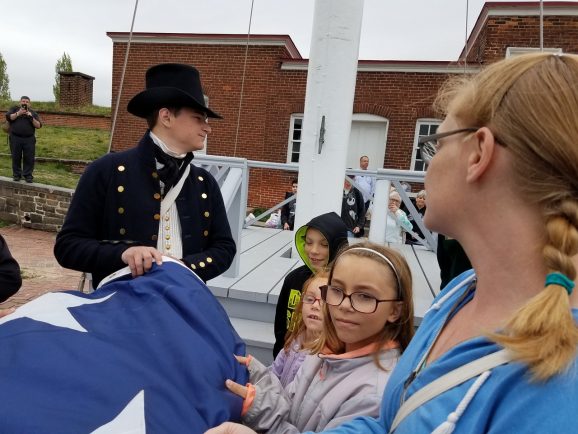Did you know the Star-Spangled Banner, the flag that flew over Fort McHenry during the War of 1812, and which inspired Francis Scott Key to pen the words to our National Anthem, has 15 Stars and 15 Stripes? Do you know why?
Visiting Fort McHenry on a Saturday turned out to be a perfect day to visit. Yes, there were a lot of people there and it was a bit crowded, but there are special programs on Saturdays, including docent-led tours and a special flag raising visitors are encouraged to participate in.
Since we were passing through Baltimore on our way to Pennsylvania, we decided it would be perfect to stop and visit Fort McHenry. We planned it out so we could stop and park overnight at a Walmart on the outskirts of Baltimore, then we got up the next morning and drove to the Fort, 5th wheel and all.
We got there just in time for the movie, which plays on a big screen and tells all about the defense of Baltimore against attacking British troops.
British attack on Baltimore
Prior to British attack on Baltimore, the U.S. had just suffered a humiliating defeat in Washington, D.C. where the British had completely overrun the American defensive positions and proceeded to burn the White House and the U.S. Capitol.
British soldiers were confident in another victory at Baltimore, where they planned to burn the city to the ground. Residents of the city watched nervously from their homes during a ferocious 25-hour bombardment of the Fort by the British Navy on September 13-14, 1814. At the same time, thousands of British troops were attempting to penetrate the eastern defenses of the city, held off by 15,000 Americans and a hastily constructed barricade.
If the British could get ships past Fort McHenry, they could land soldiers closer to the city and greatly increase their chances of success.
Through the long night, Americans in the besieged fort vigilantly maintained their post, returning cannon fire against the British ships. They stood their ground against thousands of cannon balls and rockets fired from the British. Francis Scott Key, a American lawyer whose truce ship had been detained in the harbor behind the British ships, watched the bombardment until morning, when the British guns fell silent.
As the morning fog lifted, Key watched anxiously to see if the fort had been overtaken. When the Star-Spangled Banner emerged from the haze, he knew the fort still stood. The Americans were victorious. The site of the huge flag flying over the fort inspired Key to write the words to what has become our National Anthem:
O say can you see, by the dawn’s early light,
What so proudly we hailed at the twilight’s last gleaming,
Whose broad stripes and bright stars through the perilous fight,
O’er the ramparts we watched, were so gallantly streaming?
And the rockets’ red glare, the bombs bursting in air,
Gave proof through the night that our flag was still there;
O say does that star-spangled banner yet wave
O’er the land of the free and the home of the brave?
As the men in the fort realized the British bombardment had ended and victory had been won, they burst into singing. The Star-Spangled Banner hadn’t yet been written, so what patriotic song were they singing? Yankee Doodle.
The Star-Spangled Banner – 15 Stars and 15 Stripes
During our recent visit to Washington, D.C. and the Smithsonian Museum of American History, we had seen the original Star-Spangled Banner, the central exhibit of the museum.
During our visit to Fort McHenry, we got to participate in a flag ceremony, where a replica of the original flag was raised.
Why the 15 stripes? In the Flag Act of 1794, Congress added two new stars and two new stripes to the flag in honor of two new states, Vermont and Kentucky. This flag lasted until 1818, when Congress declared a new star would be added for each new state to join the U.S., but that the number of stripes would remain at 13.
During the War of 1812, this 15-stripe flag was the current Official United States Flag. After the Battle of Baltimore, the flag seen by Francis Scott Key was aquired by the Fort’s commander, Major Armistead. It was passed down through his family until his grandson gifted it to the Smithsonian, on the condition that it be always on display to the public.
Junior Ranger Badges:
Fort McHenry
Travel Tips:
- Fort McHenry has Bus and RV parking, but it is all back-in slots, so be prepared. To get to the Fort, take exit 55 on I-95 North. RVs are not allowed to go through the Fort McHenry Tunnel, so you cannot come from I-95 headed south if driving an RV. After taking exit 55, follow the signs for Fort McHenry. Don’t trust Google Maps, it will try to take you down alternate streets where RVs can’t go.
- You can raise your own flag at Fort McHenry. Either bring your own or buy one in the visitor center, then you can take it out and raise and lower it over the fort. They will give you a certificate stating the flag was flown over Fort McHenry.











